Of mangroves, mosques, and human mobility: Bohol delegation finds solutions, solidarity in Central Java
01 August 2024|Elise Arya Chen and Cathy Torres
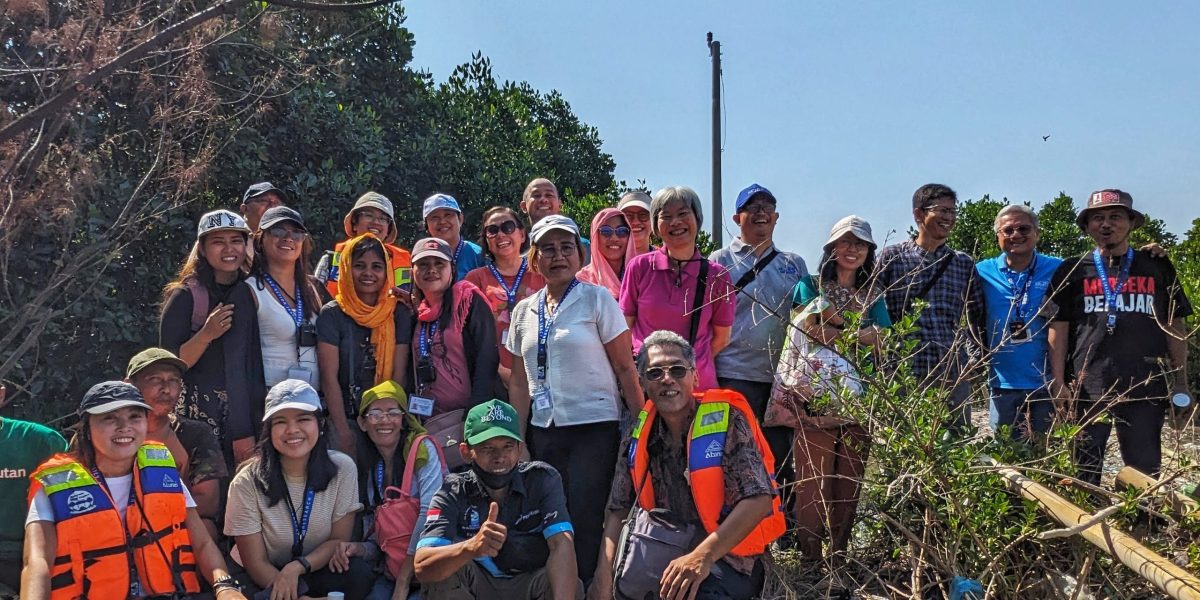
A light summer breeze blows through the semi-outdoor arrival hall of Semarang Airport in Central Java, Indonesia, providing some relief from the tropical heat. Despite the worst of the May heatwave being over, the warm humidity still lingers in the air, a reminder of the rapid planetary heating humanity is experiencing with climate change.
Climate change is high on the agenda of the Filipino passengers who emerge from the arrival hall, wearing lanyards that say ‘Research and Advocacy for Climate Policy and Action’ (RACPA). They are greeted by a team from the Institute of Social Democracy, Research and Social Justice, also known as Percik Institute, who have travelled from their base in the cool hills of Salatiga. Thus officially begins the cross-country, cross-community exchange visit—from the Philippines to Indonesia, from Bohol to Central Java—which is RACPA’s culminating activity for its first year.
RACPA is a five-year project supported by the Australian Government through Caritas Australia, that aims to better understand the climate change and human (im)mobility nexus in the context of coastal and island communities in Indonesia and the Philippines. For its first year, which began in July 2023, the project’s focus has been on research to generate evidence that will inform subsequent advocacy and community adaptation efforts.
Implementing the project is a consortium formed by the Jesuit Refugee Service Asia Pacific (JRSAP), Environmental Science for Social Change (ESSC), and Percik Institute. For the exchange visit, they are joined by four community researchers from Nocnocan Island in Talibon Municipality, Bohol Province—Fatima Bacaltos, Zemirah Belleza, Marcel Cabando, and Zairah Lyn Valenzona, as well as four local government officials: Lirio Evangelista-Du, Municipal Administrator, and Engr. Gerry Araneta, Municipal Planning and Development Coordinator & Focal Person for Community Based Monitoring System (CBMS), both of Talibon Municipality, and Engr. Ronilita Bunado, Special Project Coordinator for the Provincial Planning and Development Office, and Maria Villa Pelindingue, Coastal Resource Management Division Head, Bohol Provincial Environment Management Office, from the Bohol Provincial Government.
Day One: Tambakrejo, Semarang
After a half-hour drive from Semarang city centre, the delegates make their first stop in the RT04 neighborhood of Tambakrejo, a fishing village, to hear from CAMAR, a community group sustaining a mangrove plantation since 2011. CAMAR stands for Cinta Alam Mangrove Asri dan Rimbun, which translates to ‘Love the Beautiful and Lush Mangrove Nature.’ This morning, one of its founders, Yayin Zazid, welcomes the group and tells them about CAMAR’s work.
It has been a long learning journey for Pak Yayin and his team since they first began planting mangroves in 2011 as part of a CSR project of Pertamina, Indonesia’s national energy company.
Along the way, they picked up mangrove planting skills and knowledge from many different sources and worked tirelessly to overcome the skepticism of some fellow villagers to help their community build resilience against soil erosion caused by sea tidal flooding, otherwise known as rob.
Two Google Earth satellite images hanging side-by-side on the wall of their community hall record the fruit of their labor: the bare grey embankment shown on the photo on the left captured in 2013 has been transformed into a lush green space in the other photo, taken in 2022—a stark difference.
Keen to see the results with their own eyes, the group boards three colorful wooden boats that take them across the calm waters of the bay to CAMAR’s mangrove site. In recent years, it had been turned into a leisure park, complete with a jogging trail. The boats carrying the group used to ferry joggers and other visitors to the site, until severe flooding earlier this year damaged the infrastructure.
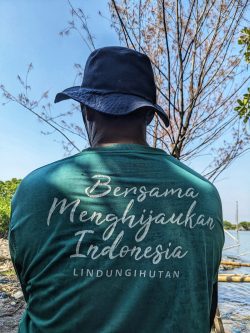
A stone’s throw from the place are the remnants of a fueling station put up by Pertamina in 2016, now half-submerged. As the boats dock, the delegates are greeted by a CAMAR team member, who shares that the site was once a gravesite for deceased villagers before the frequent rob washed much of the surface land away. A gravestone barely peeks from beneath the sandy soil, painting the grimness of how even the departed find no reprieve from the effects of the climate crisis.
The group gathers near a bamboo structure filled with mangrove seedlings, as Pak Yayin walks them through the mangrove planting process. For the Nocnocan community delegates, the session is especially interesting as they seek their own nature-based solutions to reduce erosion on their island. Although the soil on their island is sandier, which is less ideal for mangroves, they are hoping the experiences of the people they will meet during their visit to Central Java can help them find a suitable variety that would take well to sandy soil.
As afternoon rolls in, the delegation travels back to land for a wrap-up session with Pak Yayin. The group is abuzz with questions following their visit to the mangrove plantation. Before departing, they sample two types of mangrove crisps made by a local women’s group and packaged for retail: a savoury version made of mangrove leaves coated in batter and a sweet version made of flour milled from mangrove fruit. Pak Yayin also shows them some bird sculptures made out of recycled marine litter, another environmental issue the coastal village must contend with.
As the group makes their way to RT01 for their next activity, they are in for a surprise: the narrow street, dry and dusty when they had driven in that morning, was now covered with water and mud as the high tide builds and spills into the village. As the car inches along, small children returning from school skirt the sides of the street, carrying their shoes to keep them from getting wet. The women of Nocnocan click their tongues. They are no stranger to floods, but the thought that the villagers of Tambakrejo must deal with it on an everyday basis is difficult for them to imagine.
From RT01, the group strolls over to RT06, where 97 households were relocated by the government to temporary row housing in 2021 following joint advocacy by the community and their allies from civil society. The original plan was to have the residents move to flats far from their fishing grounds after their removal from the banks of the nearby East Flood Canal to make way for a river “normalization” project.
Here, the Bohol delegation meets Dani Rujito, a fisherman, who proudly tells them that they only use traditional fishing techniques, avoiding illegal methods that harm the environment. Meanwhile, Marzuki, who leads a youth group that plants mangroves, shares that he first learned about the benefits of mangroves when he was 11, from another mangrove-planting project. Since then, he has been carrying out his own research and learning from trial and error. He has learned, for example, that mangrove saplings cannot stand on their own and need to be supported by stakes or used tires, something he now shares with the delegates from Bohol.
After their conversation with the two gentlemen, the team make their way to the RW16 village hall located in RT04, where a hearty lunch of freshly caught fish and squid prepared by the villagers awaits them. After the meal, they meet Slamet Riyadi, the Tambakrejo village leader, who shares his community’s experience in dealing with climate change.
He describes the issues stemming from and beyond the tidal flooding which visits their coastal community almost daily, including the rubbish that washes onto the streets and alleys. Ailments such as diarrhea and skin rashes are common among villagers, he explains. Over the years, fishermen have also suffered from declining catch and resorted to cultivating green mussels, shifting their livelihoods to survive. Like most communities impacted by similar climate-related occurrences, life grows harder, but local resilience shines through in the villagers’ adaptation and mitigation efforts, such as CAMAR’s mangrove plantation.
For the final activity for the day, the group travels back into Semarang City to the Regional Development Planning Agency (Bappeda). There, they meet Purnomo Dwi Sasongko, the Secretary of the Regional Development Planning Agency, and Dianis Januar Khoirunnisa, from the Regional Natural Resource Development Planning Agency, who share about the history and overview of their city. Historically a major port during the Dutch colonial era, Semarang was reliant on agriculture before becoming an industry-heavy area. Now, the city aims to transform itself yet again, into one more focused on trade and tourism.
Pak Purnomo explains that Semarang, like other parts of Indonesia, faces various disaster risks including floods, sea inundation, land subsidence, landslides, and droughts. Recognizing that these issues are too immense for a single institution to address alone, he shares that they regularly collaborate with NGOs and universities, leveraging their technical expertise.
As the afternoon sun slowly wanes, the session wraps up with questions from the delegates to the speakers. The government representatives from the Philippines take the opportunity to inquire about initiatives and measures in Semarang that could be transferred to their own context, from sanitation to disaster risk reduction (DRR).
Another form of transfer crops up in the conversation: the movement of people. Pak Purnomo notes that relocating people from unsafe to safer areas is a key part of DRR, albeit a challenging one. For people to move, “the area where they will be relocated has to be better than where they are coming from,” he observed.
Day Two: Wonoagung, Demak
Masjid Agung Demak, where the delegation begins their second morning in Central Java, is a stunning grand mosque built in the late 1400s. It features traditional Javanese architecture, reminiscent of ancient Hindu-Buddhist structures, and is made almost entirely of timber. The roof shingles were originally made of teak, possibly to help them withstand sea spray–teak was also widely used in shipbuilding–as the mosque’s location is believed to have been originally closer to the sea. It is a reminder that many of the structures on which human activities center are built on shifting terrain.
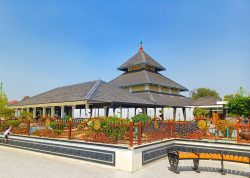
After paying their courtesies at the local landmark, the group sets off to the Demak Regency Government office. Eko Ariyanto, who heads the Natural Resources and Environmental Maintenance at the Environmental Service Department, meets the delegation and shares about his department’s efforts in mitigating and adapting to climate change. Although Demak does not have any small islands under its jurisdiction, which poses particular problems for evacuation as well as mobilization, it has limited resources, mainly relying on agriculture and sea produce.
He shares that the worsening impacts of climate change have been especially palpable over the last 20 years, with back-to-back flooding in Demak in the first quarter of this year, the second of which saw 30 centimetres of water at the regency centre. Recognizing the severity and impact of such disasters, Pak Eko strongly believes collective effort is required from a larger group of players across a wide area to address climate issues. While at the community level, coastal households that can afford it build stilt homes high enough to avoid their houses being flooded, on a larger scale, the recently built highway has also served as a coastal barrier between the water and inner land. Pak Eko acknowledges that while coastal communities should ideally relocate for safety, he understands the difficulty families face in leaving their communities and place of origin to start afresh elsewhere.
In the second half of the day, a short drive takes the delegation to the village of Wonoagung in Demak. In contrast to Tambakrejo in Semarang, Wonoagung is more rural, having once been known as one of the granaries of Central Java. Still, while further located from the coast than Tambakrejo—Glagah Wangi Beach is five kilometers away—it faces similar challenges of regular rob flooding.
Groups of young children hanging around the nearby compound waiting for their religious classes curiously watch the visitors as they make their way to the Wonoagung community hall. Zidan Muhyidin, the village head, welcomes the villagers to the looming community hall for lunch, to be followed by a dialogue between the delegates and his team. The height of the hall, which seems unusual for its location, factors in the likelihood that it may need to be raised several times because of the land subsidence and flooding, he explained.
Ten years ago, the village had vast fields of rice paddy, but according to the village leader, nearly all of the rice farms have been converted into fish ponds after the intensified occurrence of rob. The salty seawater which regularly floods the village no longer enables the sustenance for regular rice paddy yields, forcing farmers to switch their livelihoods. Only a few have been able to continue planting rice, thanks to higher embankments and ideal locations.
He expresses some worry for the future of his community, who have had to endure losses and challenges in picking up the necessary skills to survive on their new livelihood, whether running fish ponds or working for one of the many factories now operating near the village. While many families have to spend their hard-earned savings to raise the floor of their homes each year to avoid flooding, his team is currently working on local initiatives to address soil abrasion. Like the community in Tambakrejo, they believe that mangroves can help protect their land, and additionally serve as an avenue for increased livelihoods, for instance, serving as an ecotourism attraction in the area.
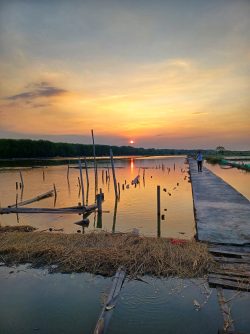
Representing the Nocnocan community, Zairah responds with a sharing of their island’s own experiences dealing with climate-related disasters. While the specific context of their island differs from Wonoagung’s, they understand the struggles and concerns faced by the community, as climate change impacts worsen and people living on the frontlines endure growing hardships globally. Out of the many challenges faced by the Nocnocan community, the worst in recent years has been due to Typhoon Rai, or Typhoon Odette as it was known locally, which affected their island in 2021, causing significant loss and damage, washing away some homes and flooding nearly all the rest.
The smallest and farthest from Talibon Municipality in Bohol, their island hosts 415 households, more than half of which are almost fully dependent on what they catch from the sea. As a densely populated island, seeming more like a sandbar during high tide, they have no space to grow plants and nearly everyone fishes for sustenance and livelihood. Aside from the costs incurred to repair the typhoon damage to their homes, their top non-food expense is their children’s education. Nocnocan only has an elementary school onsite, and those attending high school must do so in the neighboring island or the mainland.
Nocnocan’s story resonates with the locals of Wonoagung. “We have many similarities with the community in Nocnocan,” Wahib Eko says. His fellow community researcher Nasirin adds, “The main difference is the type of disaster that affects us. They experience typhoons and strong waves, while we mostly face flooding from tidal rob.”
Before the day closes, the village head takes the delegation to see a water pumping and sanitation facility run by the local government. The group then makes their way to the bridge between Wonodadi Kidul and Wonodadi Lor hamlets, where a sluice gate controls the flow of water: salt water to the west, fresh water to the east. Here, they board wooden boats yet again and float down the B7 Sipon River, admiring the lush mangrove trees on both sides and ducking beneath the occasional net strung above a rumpon, a traditional fish aggregating device that is said to be environmentally sustainable.
The boats dock at Karang Tarub hamlet and the group cross a rickety bamboo bridge. Showing what local residents have to contend with on a daily basis, they then have to navigate their way across a ladder placed horizontally over brackish water pooled in the narrow alleys near the river. They walk around the hamlet and watch a fishpond owner feed fingerlings, meeting friendly locals along the way and stopping for a quick snack of freshly steamed corn from a village vendor.
Near dusk, they return to the boats that gently cut their way through the water back towards the bridge with the sluice gate. The silence is broken only by the call to prayer from local mosques, and by the cry of birds coming home to roost in the mangroves lining both sides of the river. As they pass by each rumpon, one of the boatmen disembarks into the shallow water and re-ties the nets that had been untied earlier to make way for the boats, a reminder of the importance of treading lightly and minimizing the impact of human actions on communities and the environment.
Day Three: Multi-stakeholder Forum
On their last day, the Bohol delegation arrives at the Banjardowo Catholic Church in Semarang to meet anew with their community counterparts from Tambakrejo and Wonoagung, alongside representatives of local NGOs, the academe, and the government. The multi-stakeholder forum aims to tie together the various themes that had been raised and explored during the cross-country exchange visit.
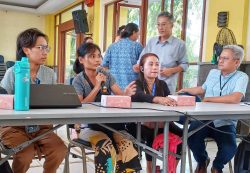
Each of the communities shares their experiences related to climate issues, including the findings of their community research and mapping efforts under the RACPA project. Guests from Tambak Mulyo, a community neighbouring Tambakrejo, likewise take the floor and share about their One Family, One Mangrove project supported by JRS Indonesia in partnership with the local Business Assistance Institution for Workers, Farmers, Fishermen (LPU BTN). Afterwards, government representatives, both from Central Java and Bohol, present their respective approaches and initiatives in the area of climate change mitigation and adaptation.
The session is rich with sharing from multiple perspectives, illustrating concerns and challenges faced by different stakeholders, yet uniform in the recognition that these issues have had, and continue to have, alarming effects. Despite the differences faced by the communities in Indonesia and the Philippines, a concluding message of resilience and perseverance echoes during the session.
After the program ends, the Nocnocan community members sit down with the team from Tambak Mulyo, to seek advice on their planned mangrove-planting initiative on the island. The moment captures the exchange visit’s key achievement: individuals and communities learning from each other’s lived experiences of adapting to climate change
“On our island, we struggled to plant mangroves and had a lot of questions about why they would not grow,” Fatima, one of the Nocnocan delegates, said. “We were able to find some answers from this trip so that our homes can be protected from the high tides when typhoons happen.”
Pak Slamet of Tambakrejo echoes the sentiment. “I learned that the Nocnocan community has worked hard to find their own ways to overcome the impacts of climate change,” he said. “They also have disaster preparedness plans and I am inspired to bring this back to my community to try to create our own.”
A cool morning breeze blows through the departure hall of Semarang Airport in Central Java, Indonesia. The sun has barely risen as the RACPA delegation from the Philippines makes their way to the check-in counters, laden with ideas from their brief sojourn in Central Java.
While some of these ideas may prove harder to transplant than that of planting mangroves, even they may inspire hope, perseverance and resilience in a small island community like Nocnocan. After all, what matters in the end is the shared longing for safe and solid ground on which to build something one might call home—a home to return to, come rain or shine, like those birds’ nests in the mangroves of Wonoagung.

